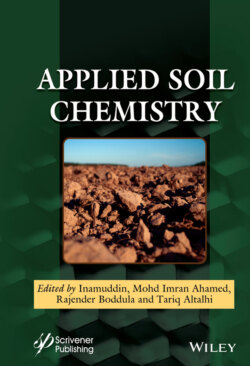Читать книгу Applied Soil Chemistry - Группа авторов - Страница 40
2.1 Introduction
ОглавлениеWeathering of rocks can be defined as the modification in the rate of composition and consolidation, occurring in the crust of earth under the influence of hydrospheric and atmospheric factors [1]. It has two different categories: chemical and physical. Physical weathering is defined as formation of unconsolidated state of rock from consolidated rock. In case of chemical weathering, there is chemical composition modification either in the unconsolidated or consolidated rock. Merrill et al., in the year 1906 [2–4], elaborated weathering as insincere changes caused in masses of rock due to atmospheric conditions, thereby causing complete or partial damage of the rock.
Physical weathering was referred as disintegration, whereas chemical weathering referred to as decomposition. As already discussed, in case of physical weathering, large masses of rock get converted into elastic or unconsolidated state, owing to the hydrospheric and atmospheric factors. Polynov et al., in the year 1937 [5–7], states that weathering is a cyclic, complicated procedure which involves breakdown of solid structure of rock and production of enhanced interfacial interaction between the rock and nearby surrounding.
By mechanical conditions, in case of disintegration or physical weathering process, rocks break down into smaller form which retain both its composition as well its originality. For example, even though basalt gets broken down via physical weathering or mechanical means into its smaller form, it could be identified as basalt. Physical weathering of rock occurs either in place or by the media like wind, gravity displacement at steep slopes, moving water and glacial ice which carries the rock and then grind it. In place physical weathering is driven by five factors as stated by Rieche et al. in the year 1950 [8–10]. The factors include unloading, thermal expansion, crystal growth, colloid plucking, and pressure and abrasion due to animals and plants. When there is reduction in confining pressure due to joints, cracks, erosion, and uplift, unloading causes rock masses expansion. According to Polynov et al., in the year 1937 [5], thermal contraction and expansion is vital factor, but as per Origgs et al. and Blaclrwelder et al. [11, 12], it is comparatively not important. Crystal growth causes production of prying action on minerals and rocks. This involves activity due to frost and also up to some extent formation of crystals due to chemical weathering, for example, as per Humbert and Marshall, in the year 1943 [13–15], quartz physical weathering occurred due to films of iron oxides. Colloid plucking refers to the physical damage occurred owing to the reduction of colloidal matter, resulting in peeling of the rock surface. According to Kellog et al., in the year 1943 [16–18], destruction of rocks occurs due to overgrowth of roots of the plants.
On the other hand, chemical weathering refers to modifications in the rocks’ chemical properties, owing to the hydrospheric and atmospheric factors. It is also known as the process of decomposition of minerals and rocks. The substance formed after the process of chemical weathering must include new mineral (mechanism of synthesis) or after the weathering the products should exist as residue after the elimination of other constituents (mechanism of residue). According to Polynov et al., in the year 1937, the product obtained as per mechanism of synthesis is known as products of accumulation and the product obtained from mechanism of residue is known as ortho eluvium. Moreover, the solutes getting washed and accumulating in ground water are also considered as weathering products, but in the context of mineral content of soil, it is of least importance. This chapter discusses background of chemical weathering of minerals, sequence of weathering of minerals from soil, mainly throwing light on the factors which controls the rate of chemical weathering like temperature and time factor, biotic process, oxidation, reduction, water, leaching, acidity, and many more.
